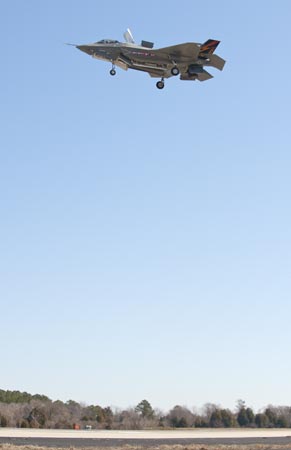 Lockheed Martin announced March 17 that the F-35B short takeoff/vertical landing (STOVL) variant had demonstrated its hover capability during a test flight at NAS Patuxent River, Md. The test, according to a company release, “confirmed predictions of the jet’s vertical thrust, stability, and control in hovering flight.” F-35 lead STOVL pilot Graham Tomlinson took off conventionally before converting to STOVL mode at 200 knots airspeed. Tomlinson then slowed the aircraft to 60 knots and flew a decelerating approach to a zero airspeed hover at 150 feet above the runway, marking the first free air hover in the F-35B. Following execution of controllability test points in the hover mode, he executed a STOVL landing at 70 knots. Later in the day, BF-1 performed the first F-35 short takeoff. Next step for the Marine Corps variant of the strike fighter is its first vertical landing.
Lockheed Martin announced March 17 that the F-35B short takeoff/vertical landing (STOVL) variant had demonstrated its hover capability during a test flight at NAS Patuxent River, Md. The test, according to a company release, “confirmed predictions of the jet’s vertical thrust, stability, and control in hovering flight.” F-35 lead STOVL pilot Graham Tomlinson took off conventionally before converting to STOVL mode at 200 knots airspeed. Tomlinson then slowed the aircraft to 60 knots and flew a decelerating approach to a zero airspeed hover at 150 feet above the runway, marking the first free air hover in the F-35B. Following execution of controllability test points in the hover mode, he executed a STOVL landing at 70 knots. Later in the day, BF-1 performed the first F-35 short takeoff. Next step for the Marine Corps variant of the strike fighter is its first vertical landing.
A new White House new executive order, “Ensuring American Space Superiority,” emphasizes space security as a high priority for President Donald Trump and underlines the Space Force’s role in not only defending U.S. assets, but also in the attack mission.

